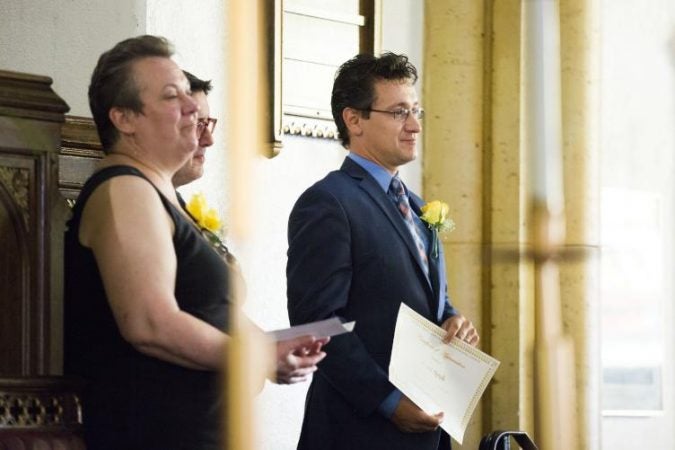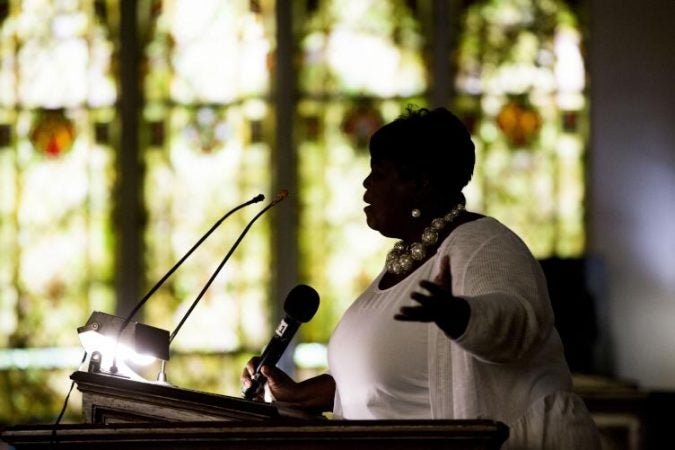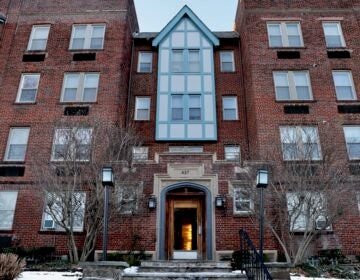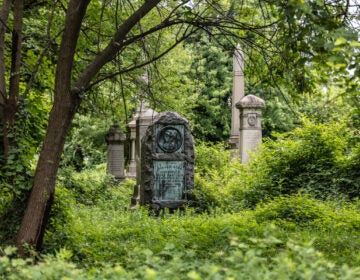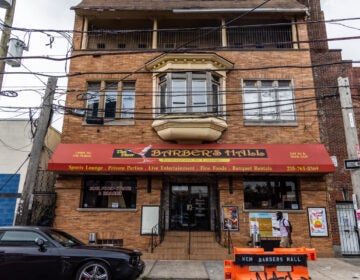Hickman Temple AME celebrates a win in the effort to preserve its historic church
Observers of Philadelphia’s real estate scene know how this story usually goes.
Listen 3:37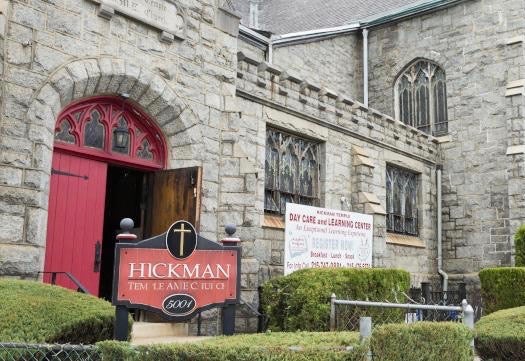
Hickman Temple AME Church, its facade reinforced and its doors open for its first Sunday service since April 2017. ( Rachel Wisniewski for WHYY)
Hickman Temple AME dominates the corner of 50th Street and Baltimore Avenue in West Philadelphia. This block-long, century-old church of slate and stone is a neighborhood icon in Cedar Park, a fast-changing neighborhood on the outskirts of the territory serviced by the University City District.
Originally built in 1898 by the Presbyterians, the building began to show its age in recent years. Most noticeably, the sanctuary’s 50th Street façade began to separate from the main body of the structure after a particularly grueling winter — a 9-inch gap opened up between the roof and the wall. The city’s Department of Licenses and Inspections (L&I) became so concerned about Hickman’s worsening condition that in 2017 it forced the congregation to worship elsewhere.
“It’s been hard and depressing,” said Althea Mosley, a worshiper whose parents helped found the AME congregation. “Our parents worked hard in this church, this is our life right here in this church. We’ve been in the wilderness this whole year.”
Neighbors became concerned about Hickman’s future when fencing appeared around the façade, blocking off the sidewalk and parking spaces in front of the building to assuage L&I’s fears of potential falling debris.
Observers of Philadelphia’s real estate scene know how this story usually goes: As congregations across the city shrink, and their historic churches age, the amount of work needed often outstrips the worshipers’ capacity to pay. In redeveloping neighborhoods such as Cedar Park, developers are eager to snap up the old buildings for demolition, to be followed by new construction.
Between 2011 and 2015, a Pew Charitable Trusts report says, at least 23 historic churches were demolished, most of them by developers. Last year, the congregation of Christian Street Baptist Church in Bella Vista sold it to South Philly townhouse tycoon Ori Feibush because the members could not afford to maintain the building. The distinctive red sandstone and red brick church fell to the wrecking ball in July.
But Hickman Temple AME decided on a different game plan. With the help of local institutions, it sought to shore up the building, bring the congregation back, and devise a long-term strategy to fix the structure’s many ills.
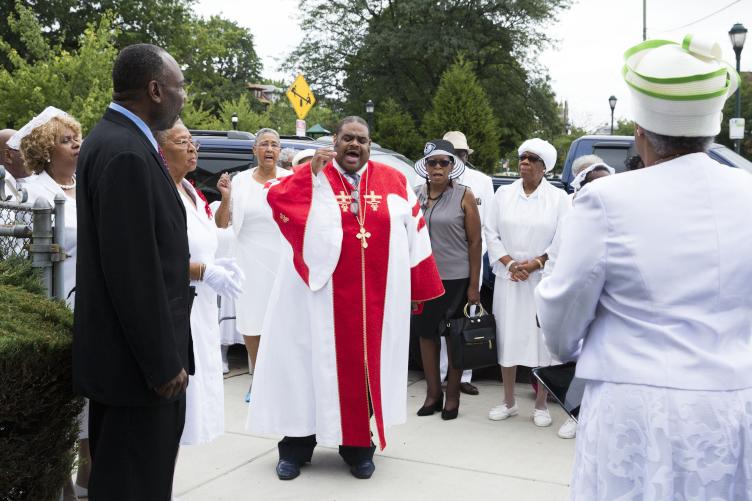
“This is not the first time I’ve come to a church where there was work that needed to be done, but this is the first one where the church was worshipping somewhere else because of it,” said Gregory P. Nelson, who became Hickman’s pastor in January. “So I came, I looked, I prayed, and then I put together a plan. You can pray all day, but you have to get up from praying and come up with a plan.”
Over the last seven months, Hickman Temple embarked on an extensive effort to raise funds for the installation of an enormous steel brace on the outside of the church and roof repairs to cover the gap between the facade and the main building. The solution, while temporary, is expected to be in place for at least 10 years.
The repairs totaled $75,000, raised from the congregation, neighbors, and local businesses. But local preservation architect Kathy Dowdell, who worked with Nelson and others in the neighborhood to save the building, estimated that upwards of $1 million will be needed to fully pay for permanent repairs.
“I give Pastor Gregory Nelson and the parent church enormous credit for stepping up and finding the money even for this temporary repair,” said Dowdell, who played a key role in coordinating with structural engineers and iron contractors. “Very often, congregations want to spend [money] on something closer to their mission. The building is normally not the mission.”
The local neighborhood group, Cedar Park Neighbors, and the University City’s District’s Project Rehab played instrumental roles in getting Hickman back into its historic sanctuary.
Ryan Spak, who heads Project Rehab, said University City District wants to see the neighborhood’s historic fabric preserved. That why he connects with owners of historic properties like Hickman and helps them navigate the city’s bureaucracy and, at times, the court system. Since its creation in 2011, Project Rehab boasts of bringing 121 distressed properties back into use. In only two cases, by Spak’s count, has it failed to help save a building.
In Hickman’s case, Spak said, he helped negotiate with L&I’s construction services, presenting them with engineering reports to show that the church wasn’t imminently dangerous. And he sought permission to erect the public-safety fencing even before the church got pricey sidewalk-closure permits.
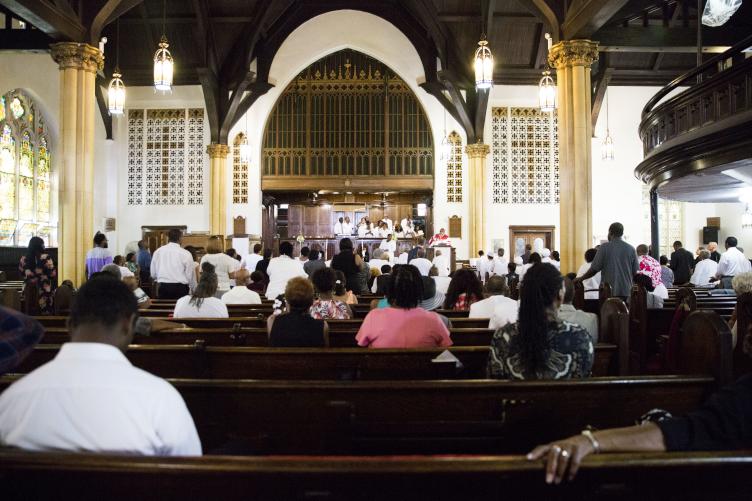
On Sept. 2, members of the congregation filed into the old building, resplendent in their Sunday best, to the tune of “We’ve Come This Far By Faith.” Over 100 worshipers massed before the doors, smiling and weeping, as Pastor Nelson spoke of the travails they had faced down.
“I’m just excited to see the Hickman family back home,” Mosley said before she and others filed into the building. “It brings back a lot of memories. And when you come back home, it’s like a family reunion. It’s a truly great feeling.”
Spak, Dowdell, and Cedar Park Neighbors’ David Hincher were at the service. After about an hour and a half of singing and praying, Pastor Nelson called them up to the front of the church, gave thanks for the services they had delivered, and pinned yellow roses to them in honor of their assistance.
“I want to highlight these people who have been instrumental in this process,” said Nelson. “You never arrive where you arrived by yourself. You don’t have what you have because of yourself. You never accomplished anything because of just you. Amen.”
WHYY is your source for fact-based, in-depth journalism and information. As a nonprofit organization, we rely on financial support from readers like you. Please give today.



